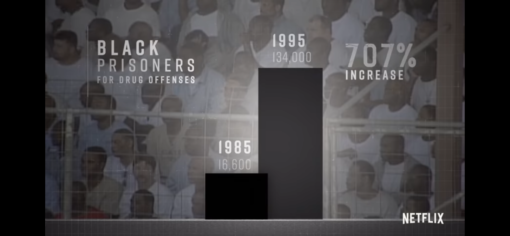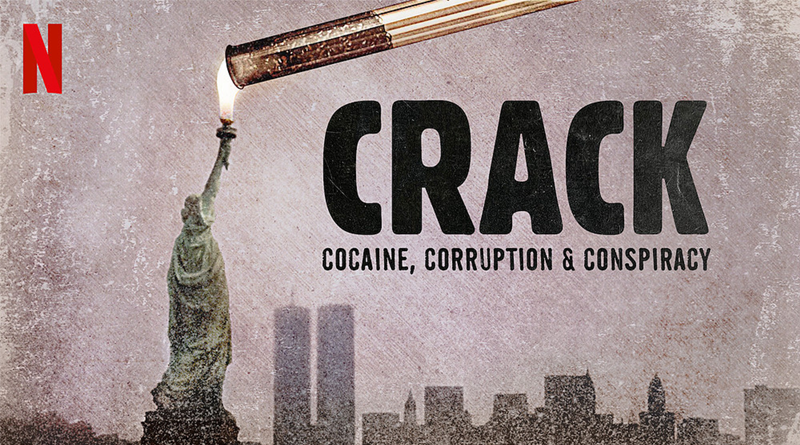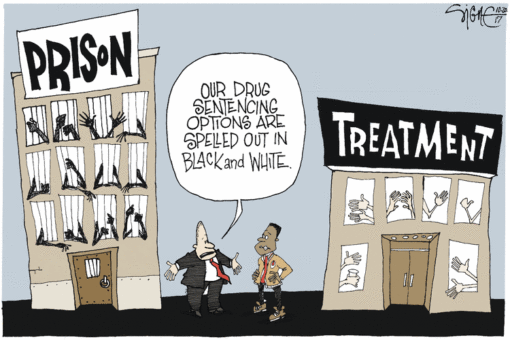This was written by Myla, one of our student interns. The opinions expressed herein do not reflect those of Civitas other than respect for the value of open dialogue.
The Netflix documentary, Crack: Cocaine, Corruption & Conspiracy highlights the devastating effect of emerging a highly addictive drug during a period of economic decline. The introduction of cocaine destroyed lives, families, and communities. During the 1980 Republican National Convention, former President Ronald Reagan accepted the nomination for the President of the United States. He made promises to improve the economy and improve American lives, especially for disenchanted white voters. He decided to stimulate a free market to pull Americans out of poverty. “For those without opportunities, we’ll stimulate new opportunities, particularly in the inner cities where they live. For those who’ve abandoned hope, we’ll restore hope and we’ll welcome them into a great national crusade to make America great again,” Reagan stated in his speech. But did the former President really accomplish his goal? In 1980, Wall Street was booming with cities growing larger every day. This ultimately led to the introduction of cocaine.
The addictive stimulant drug began as the social drug of the elite. Back then, powder cocaine was a luxury. Disadvantaged communities did not have access to the drug. According to Historian Elizabeth Hinton, “Reagan’s administration created a proliferation of wealth for a few at the expense of the many. The Reagan administration eliminated half a million people from the welfare rolls, one million people from food stamps, 2.6 million American children from lunch programs.” This resulted in the extreme poverty of inner-city residents. During 1982, America had one of the highest rates of unemployment. Due to our country’s history of racial disparities, the black communities’ unemployment rate was always twice that of the white communities.
The amount of cocaine entering the country increased by 50% between 1982 and 1994. 63 tons of cocaine was coming into the U.S. The drug was delivered through multiple routes and modes (such as airplanes and boats) from Central America and the Bahamas, resulting in the deflation of the product. In the Black community, the creation of crack cocaine was an effort to escape the trauma of poverty. The stimulant was sold at five or ten dollars a hit. This was a game-changer for low-income communities. What was once the rich man’s drug, became accessible to poor people. Well, Reagan was right about one thing: his administration did stimulate new opportunities in the inner cities. However, they were not positive opportunities.
Unfortunately, many Black men began to build businesses through drugs to make money. They were making thousands of dollars a day. Many felt like this was the most efficient way of supporting themselves and their families. The overwhelming profit led to gun violence in urban communities. Many young men obtained high-power weapons to protect their turf. According to the film, “Crack gave more people guns. More people could afford guns. And more people started to settle their differences with guns.” This is when the epidemic hit the fan. Women and children started to get caught in the crossfire of rival drug dealers. Not only were Black women being murdered in their communities, but they also became prostitutes to gain access to cocaine. Some also sold their children’s toys. The money corrupted everyone in the neighborhood. Even law enforcement was involved in the drug activity. Many police officers were paid off by drug dealers. Some stole drugs and resold them. During this period, it was all about the Benjamins.
The “Just Say No” to drugs campaign was run by former First Lady Nancy Reagan. Arguably, it could be perceived as very hypocritical. During this time, “the US government was turning a blind eye to cocaine smuggling into the United States” (Crack: Cocaine, Corruption & Conspiracy). The government supported a dictatorship in Nicaragua that was overthrown in 1979. Reagan’s administration began to financially support bands of guerrillas to take on the Marxist government in Nicaragua. However, Congress did not want to support a war in Central America. So, what does the former administration do? They started looking for alternative sources of funding. The government sold arms to Iran and took the profits (about 30 million dollars) to fund an illegal war in Central America. This led to our government disregarding the cocaine smuggling by the Nicaraguan Contras. While political leaders were fueling the drug epidemic, our justice system punished marginalized communities who were victims of their corruption. Instead of providing resources to combat the issue of poverty, the government criminalized the oppressed.

After Reagan’s administration, former Presidents Bush and Clinton strived to be hard on crime. Law enforcement targeted low-income communities and became more militarized. Police departments were transformed into elite, funded units that were given special resources and powers. In 1994, the federal anti-drug budget was up to 12 billion dollars. That’s six times what it was when Reagan was inaugurated. Millions of dollars went into expanding the prison system leading to mass incarceration in America. After this massive explosion, many people started to notice that most inmates were minorities, but two-thirds of crack users were white.
Towards the end of the film, journalist Brian Barger asks two thought-provoking questions: If you got a war on drugs, is it not a war on the people that are supplying the drugs? Or is it only a war on the victims of the drug war? Regrettably, the war was on the victims of the drug war. The crack epidemic compromised the safety and well-being of poverty-stricken communities. Since then, the U.S. government has taken a health approach to address the issue of drug abuse instead of criminalizing the users. That should have been their strategy all along. Quite frankly, the U.S. government enabled drugs to erode America’s inner cities and has yet to make amends for the devastation of communities of color. They called this a war on drugs? Well, I call this a war on marginalized communities.



Pingback:Index of 2021 Intern Student Blog Posts - CIVITAS-STL